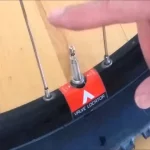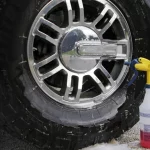Have you ever found yourself cruising down the road, only to hear a loud hissing sound from your tire? It’s a frustrating experience, as a flat tire can delay your plans and leave you stuck on the side of the road. However, if you’re fortunate enough to have a tire repair kit or have access to a tire repair shop, you may wonder how many times can a tire be plugged. Is it safe to keep repairing the same tire that has been punctured multiple times? In this blog, we will explore the answer to this common question and provide you with a better understanding of tire safety.
Table of Contents
Understanding Tire Plugs
When it comes to tire repairs, many drivers wonder how many times a tire can be plugged. The answer ultimately depends on the severity and location of the damage. Ideally, tire plugs should only be used for small punctures that occur in the center of the tread, as these are the least likely to cause long-term damage to the tire’s structure.
In these cases, a tire can typically be safely plugged up to three times before it should be replaced entirely. However, if the damage is more extensive, such as a sidewall puncture or a tear in the tire, it may not be repairable at all and will need to be replaced immediately. It’s always essential to have a professional inspect your tire and determine if a plug is a safe and viable solution for your particular situation.
Opting for too many tire plugs can compromise your safety on the road, so it’s best to err on the side of caution and replace the tire if necessary.
What is a Tire Plug?
A tire plug is a small, flexible piece of material used to repair small punctures in the tread of a tire. It is usually made of rubber or a similar material and is designed to be inserted into the hole left by the puncture, sealing it and preventing air from leaking out. Tire plugs are a popular and cost-effective way to repair minor tire damage, as they can be easily installed without the need for special tools or expertise.
They are also a good option for temporary repairs, as they can be quickly installed in the event of an emergency, allowing you to get back on the road and to a more permanent repair solution. Overall, tire plugs are a handy tool to have on hand for any driver who wants to be prepared for unexpected tire damage.
How is a Tire Plug Installed?
Tire plug installation is vital to know if you want to be prepared in case of a flat tire. A tire plug is a quick and straightforward solution to a puncture, but it doesn’t work for all tire damages. Most importantly, if the puncture is too significant, the tire may need to be replaced.
To install a tire plug, the first step is to locate the puncture and remove any debris from the tire. Then, use a reaming tool to create a clean hole before threading the tire plug through the insertion needle. Finally, insert the tire plug into the hole and trim off any excess material.
Remember, tire plugs should only be used as a temporary solution, and it’s essential to have a professional check the tire as soon as possible.
Pros & Cons of Tire Plugs
Tire plugs can be a convenient and cost-effective way to repair a punctured tire. They are designed to seal the hole from the inside, preventing air from escaping and allowing you to continue driving. One of the main advantages of tire plugs is that they are easy to use, even for those with limited mechanical skills.
They can also be used to repair punctures in most types of tires, including car tires, truck tires, and even motorcycle tires. However, there are some downsides to using tire plugs. First, they are not a permanent solution and may need to be replaced after a certain period of time.
Second, they may not be effective in repairing large punctures or damage to the sidewall of the tire. Finally, tire plugs may not be suitable for use in high-speed or high-performance vehicles, as they could potentially fail under extreme stress. Despite these drawbacks, tire plugs are still a good choice for most everyday drivers who need a quick and easy solution to repair a flat tire on the go.
The Limitations of Tire Plugs
As much as we may wish it weren’t true, tire plugs do have their limitations. The truth is, a tire can only be plugged a certain number of times before it becomes unsafe to continue using it. While there is no hard and fast rule as to how many times a tire can be plugged, most experts agree that two or three is the maximum number of times a tire should be plugged.
After that, it’s best to replace the tire altogether. Why is this the case? Well, tire plugs are designed to be a temporary fix. They are essentially a band-aid solution that is meant to get you back on the road quickly, but they are not a long-term solution.
Over time, the tire will continue to wear down and become weaker, making it more prone to blowouts or other types of damage. So while tire plugs are certainly a convenient and cost-effective solution in the short-term, they are not a permanent fix for a damaged tire.
Manufacturer Recommendations
When a tire gets punctured, we often think of using a tire plug as a quick fix. However, tire manufacturers recommend against relying solely on this solution. While a tire plug can be a temporary fix for minor tire punctures, it cannot repair larger holes or damages to the sidewall of the tire.
Even if the plug holds up for a while, it cannot guarantee the same level of safety and stability as a properly repaired or replaced tire. Plus, tire plugs cannot address any internal damage to the tire that may have occurred as a result of the puncture. It’s important to always follow the manufacturer’s recommendations when it comes to tire repair and replacement to ensure your safety on the road.
So, before considering a tire plug as a solution for a punctured tire, consult your manufacturer for the proper course of action.
Industry Standards
When it comes to tire repairs, using a plug may seem like an easy and convenient solution. However, it’s important to understand the limitations of tire plugs and why they may not always be the best choice. In the industry, tire plugs are considered a temporary fix and are only recommended for small punctures in the tread area of the tire.
This is because plugs can weaken the structural integrity of the tire and may fail under certain conditions, such as high speeds or extreme weather. It’s essential to follow industry standards and have a qualified professional inspect the tire to determine the best course of action for repair. By doing so, you can ensure your safety and the longevity of your tires.
So, while plugs may provide a quick fix, it’s important to prioritize safety and follow the advice of industry experts.
Factors to Consider
When it comes to tire punctures, it’s important to consider safety as well as the possibility of long-term damage to the tire. While tires can be plugged multiple times, it’s important to consider the location and size of the puncture. If the puncture is on the sidewall or shoulder of the tire, it cannot be plugged as it can compromise the tire’s structural integrity.
Additionally, if the puncture is larger than ¼ inch or if it is too close to the edge of the tire, it also cannot be plugged. It’s essential to consult a professional to analyze the damage and offer recommendations, as driving on a patched or plugged tire can lead to further damage or even failure, ultimately putting yourself and others at risk. Therefore, while the number of times a tire can be plugged may vary, safety should always be the top priority.
Location of the Damage
When it comes to determining the location of damage in your home, there are several factors to consider. One of the first things you should think about is the type of damage you are dealing with. For example, if you have a leak in your roof, the damage will be located in the ceiling or walls below.
Similarly, if you have a plumbing issue, the damage may be located around fixtures or within the pipes themselves. Other factors to consider include the age of your home and the materials used to build it. Older homes may be more susceptible to damage due to wear and tear, while homes built with cheaper materials may be more likely to experience damage from weather events.
Overall, understanding the factors that contribute to damage in your home can help you take the necessary steps to prevent it from occurring in the first place.
Tire Age & Condition
When it comes to tire safety, age and condition are two important factors to consider. Even if your tires have plenty of tread left, they can still become unsafe due to age or damage. Tires can degrade over time, causing cracks in the sidewall or tread, which can lead to a blowout.
This is especially true for tires that are six years or older, as they may no longer have the same level of flexibility and strength as when they were new. In addition, extreme weather conditions, improper inflation, overloading, and hitting curbs or potholes can all affect tire condition and safety. It’s important to routinely inspect your tires for signs of wear and tear and replace them as needed, even if they look like they still have plenty of life left in them.
Don’t put your safety at risk by neglecting your tire maintenance – it’s worth investing in a new set of tires if it means keeping you and your passengers safe on the road.
Conclusion
Like a cat, a tire can seemingly have nine lives when it comes to being plugged. However, just like a feline, it’s important to understand that tires have limits and should not be subject to multiple repairs. While a skilled technician can patch a tire safely, it’s best to play it safe and replace the tire at the first sign of significant damage.
Remember, tires are your vehicle’s lifeline, and their health is crucial to your safety on the road.”
FAQs
What is tire plugging?
Tire plugging is the process of repairing a punctured tire by inserting a plug into the hole.
How many times can a tire be plugged?
It is recommended that a tire be plugged only once. Plugging a tire multiple times can compromise its safety.
Is plugging a tire a safe method of repair?
Yes, plugging a tire is considered a safe method of repair, but it should only be done if the puncture is located in the tread area and the hole is not too large.
Can all types of tires be plugged?
No, not all types of tires can be plugged. Run-flat tires, sidewall punctures, and tires with large punctures cannot be plugged.
How long does a tire plug repair last?
A properly installed tire plug can last for the life of the tire, but it is important to have the tire inspected by a professional to ensure its safety.
Can tire plugs be used on high-performance tires?
Yes, tire plugs can be used on high-performance tires, but it is important to ensure that the plug is installed correctly to avoid compromising the tire’s performance.
When should a tire with a plug be replaced?
A tire with a plug should be replaced if the puncture is too close to the sidewall or if the tire has been driven on while deflated, which can cause internal damage.



